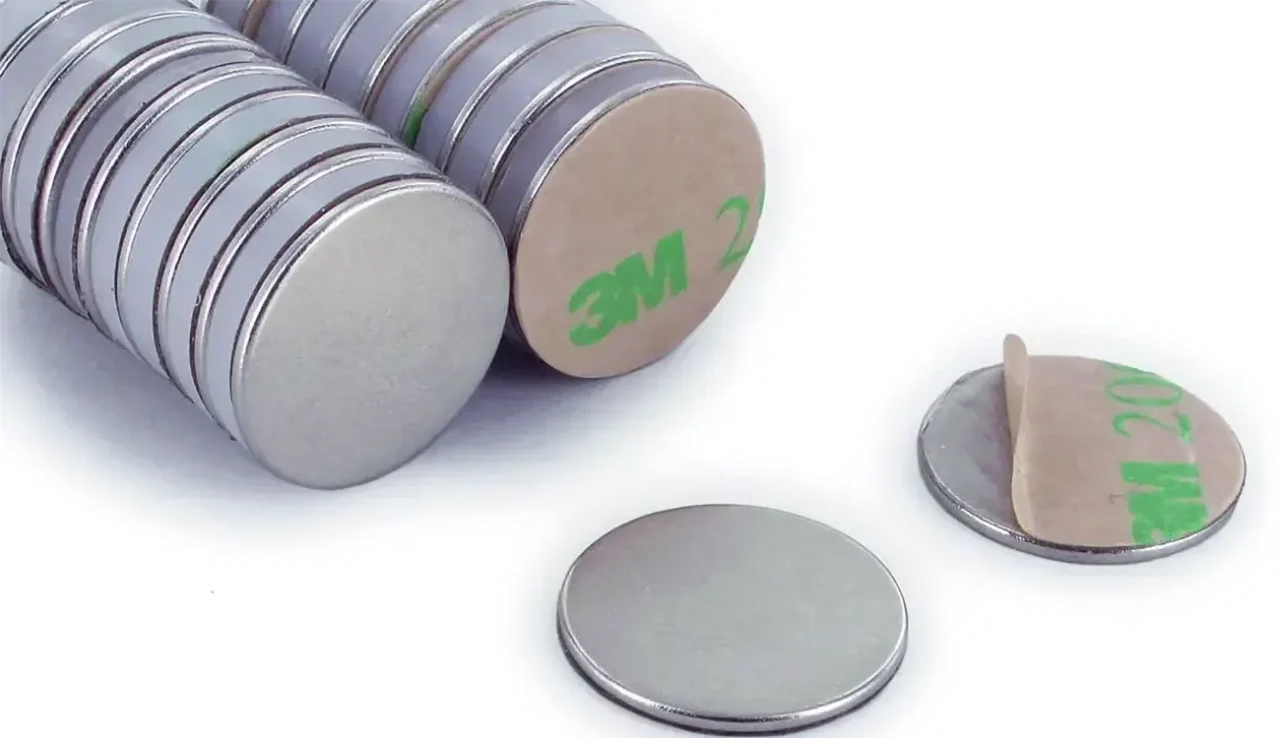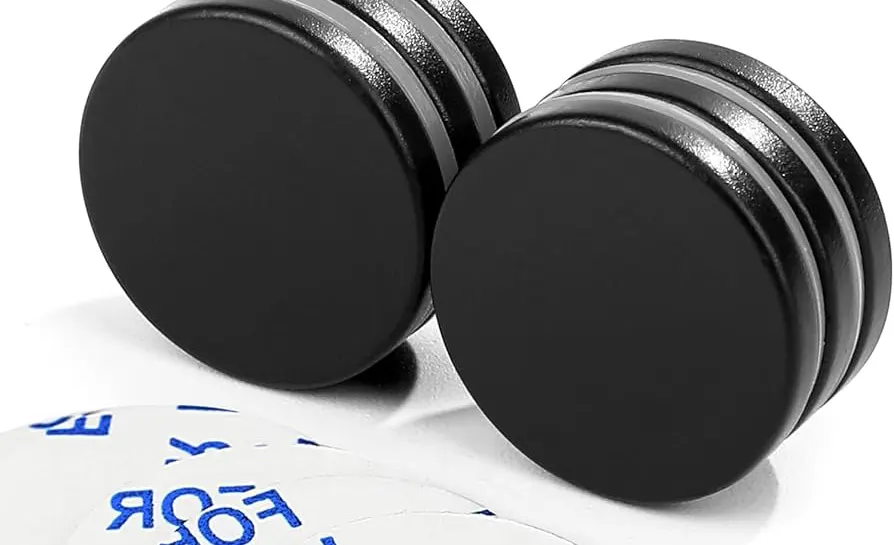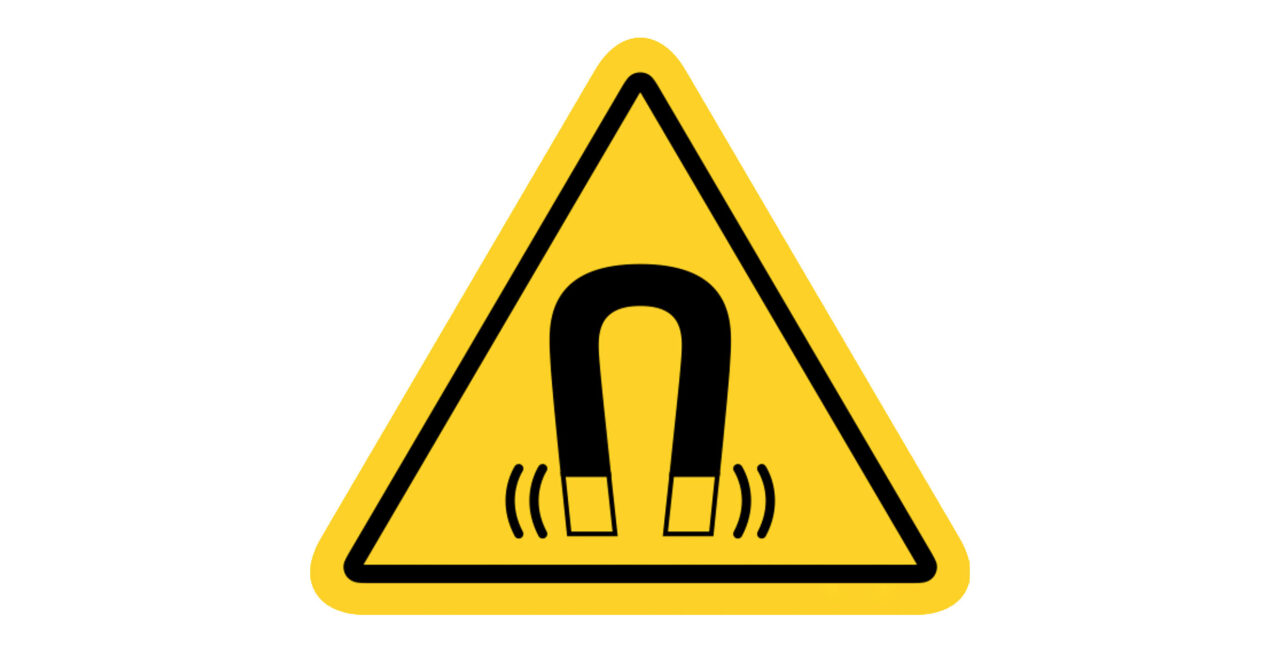Adhesive backed magnets are a convenient way to stick things together. Today, magnetic adhesives are used in a variety of ways. For example, they used to attach smoke detectors, attach magnetic boards to walls, glue metal cabinets and much more.
But has this ever come to your mind what factors influence the cost of adhesive backed magnets? Also, how high temperatures can they handle? In this article, I will try to answer all of your questions and examine the cost factors that affect their pricing.
What are Adhesive Backed magnets?
For secure and easy attachments adhesive-backed magnets are used. You can use these adhesive backed magnets for easy and secure attachment to various surfaces without the need for additional hardware or fasteners.
These adhesive backed magnets usually have a pre-applied backing of strong 3M double-sided tape or foam tape. This backing allows the magnet to stick to non-magnetic surfaces like aluminium, wood, plastic, ceramic and more. The strength of this adhesive layer is very strong. Usually, it consists of industrial-grade and high-strength capabilities. This feature of the adhesive backed magnets ensures a strong and durable bond between the magnet and the target surface.
Key Features of Adhesive Backed Magnets
Below I am going to enlist the main key features of adhesive backed magnets.
- Versatility in Application: The first and foremost feature of adhesive backed magnets is the versatility of use. Adhesive backed magnets are super versatile. You can use these adhesive backed magnets for a variety of purposes. From lightweight craft projects to heavy-weight tasks, wherever you need them. They come with pre-applied adhesive. So, there will be no need for screws, nails, or other mounting hardware. In this way, these adhesive backed magnets simplify the process of installation and reduce the risk of damage to the surface.
- Strength and Durability: When you see adhesive backed magnets you will notice they are very sleek and look like they can’t bear heavy-duty tasks. But despite their slim profile, adhesive backed magnets offer considerable magnetic strength. Adhesive backed magnets are fully capable of holding a variety of objects securely in place. Furthermore, these adhesives used are typically designed to withstand different types of environmental conditions. This will ensure that the magnet remains firmly attached over time, even under challenging circumstances such as temperature fluctuations, humidity, or exposure to chemicals.
- Customizable Sizes and Shapes: Adhesive backed magnets come in a variety of sizes, shapes, and magnetic strengths. These shapes will allow them for precise customization to meet specific project requirements. No matter, if you need a small, discreet magnet for a delicate task or a larger, more powerful magnet for heavy-duty applications. Also, reliable adhesive backed magnet manufacturers can customise adhesive backed magnets to fit your exact needs.
- Ease of Use: One of the best features of adhesive-backed magnets is their ease of use. The adhesive backing allows for quick and straightforward application. You just simply need to peel off the protective liner and press the magnet onto the desired surface. And that’s all. This user-friendly design saves time and effort. Ultimately this feature makes adhesive backed magnets an efficient solution for both temporary and permanent installations.
- Surface Compatibility: You also do not need to worry about surface incompatibility. The adhesive used on adhesive backed magnets is manufactured in a way that bonds effectively with a wide range of surfaces, including metals, plastics, ceramics, glass, and even some textured materials. This broad compatibility ensures that adhesive backed magnets can be used in different types of environments and applications without compromising on performance.
-
Adhesive Backed Magnets
Heavy Duty Double Sided Adhesive Magnets Epoxy Neodymium Magnetic Strips
-
Adhesive Backed Magnets
Strong Strip Neodymium Adhesive Backed Rare Earth Magnet
-
Adhesive Backed Magnets
Adhesive Backed Fixed Bar Epoxy Magnet
How temperature-resistant are Adhesive backed magnets?
In the above section, we discussed how adhesive backed magnets work in different environmental conditions. So, now it is important to understand how adhesive backed magnets perform under different environmental conditions. Especially how they withstand it when temperature varies. Here, you must know that high-temperature resistance is a key factor affecting the life and reliability of adhesive backed magnets, especially in demanding applications. To understand this, it is important to understand, high high-temperature resistance properties of adhesive backed magnets. We will focus on the magnetic materials used and the adhesive backed magnets that secure them.
Temperature Resistance of Magnetic Materials
For high temperatures, the resistance capability of adhesive backed magnets basically depends on the type of magnetic material it uses. Also, different magnetic materials have different tolerance levels for high and low temperatures. For this reason, this resistance can significantly affect their performance.
- Neodymium Magnets: One of the strongest types of adhesive backed magnets currently available is Neodymium Magnets. Also, they are one of the commonly used types in adhesive backed magnets. However, their magnetic strength decreases when exposed to high temperatures.
Standard neodymium magnets work best at temperatures up to 80°C (176°F). However, above this temperature range, Neodymium magnet’s magnetic properties begin to degrade. As a result, there will be a loss of power. For applications that require higher temperature resistance, Osencmag offers special grades of neodymium magnets that can withstand temperatures up to 220°C (428°F). Our Osencmag adhesive backed magnets ensure reliable performance in more demanding environments.
- Samarium Cobalt Magnets: Samarium Cobalt (SmCo) magnets are another popular adhesive backed magnet choice. They are used especially in applications that require higher temperature resistance. In comparison with Neodymium Magnets, these magnets can withstand much higher temperatures. It can withstand up to 300°C (572°F) temperature. Their excellent thermal stability makes them ideal for use in extreme environments. For these high resistance capabilities, they are used in places such as aerospace or automotive applications where temperature fluctuations are common.
- Ferrite Magnets: Ferrite magnets are also known as ceramic magnets. These magnets are known for their cost-effectiveness and good high-temperature resistance. This type can operate in temperatures ranging from -40°C to 250°C (-40°F to 482°F). However, ferrite magnets are not as strong as neodymium magnets or samarium cobalt magnets. Still, their high-temperature resistance makes them suitable for applications that require extreme heat or cold.
Adhesive Materials and Temperature Resistance
The adhesive layer on adhesive backed magnets is important in determining their overall temperature resistance. Also, the effectiveness of the adhesive depends on the type of adhesive material used and the environmental conditions to which it is exposed. Some base chemistries are likely to perform better in abnormal temperatures. Epoxy adhesives are renowned for their heat resistance. Cyanoacrylate adhesives will often maintain performance in low temperatures. Base chemistry is the biggest factor that will determine an adhesive’s temperature resistance. Following are the popular adhesive material and their temperature resistance capabilities.
- Acrylic Adhesive: For its strong bonding and excellent temperature resistance properties, Acrylic adhesives are used in adhesive backed magnets. This type of adhesive can typically withstand temperatures up to 150°C (302°F). These properties make them suitable for most industrial applications. Acrylic adhesives offer good resistance to ageing, UV radiation, and chemicals. These properties will ensure long-lasting performance in a variety of settings.
- Silicone Adhesive: For applications that require even higher temperatures, silicone adhesives are an excellent choice. These adhesives can endure temperatures ranging from -60°C to 260°C (-76°F to 500°F) without losing their adhesive strength. This makes them ideal for extreme temperature environments. Silicone adhesives can be used in automotive or electronic applications. At Osencmag, we offer adhesive backed magnets with silicone adhesive layers. Our specialised silicone adhesives are ideal for use in high-temperature settings where standard adhesives might fail.
- Rubber-Based Adhesive: Rubber-based adhesives provide strong initial tack and flexibility. However, this type is generally less temperature-resistant than acrylic or silicone adhesives. Rubber adhesives are best suited for applications where the operating temperature does not exceed 70°C (158°F). For this reason, these adhesives are commonly used in applications where a strong bond is needed at room temperature or slightly elevated temperatures.
Customization for Specific Temperature Environments
At Osencmag, we completely understand that different applications require different levels of temperature resistance. For this reason, we offer different types of adhesive backed magnets. Our adhesive backed magnets come with customizable magnetic and adhesive properties. So, no matter if you need adhesive backed magnets for fluctuating temperatures like extreme heat or cold situations, we can provide a solution tailored to meet your needs. Our manufacturing experts will work with you to select the appropriate magnet type and adhesive material. The main aim is to ensure that your adhesive backed magnets deliver reliable performance, even in the most challenging environments.
So, as we can see for long-term reliability and efficiency it’s very important to choose the right adhesive backed magnets for your application. So, by understanding the temperature resistance of both the magnetic materials and adhesives used, you can make informed decisions that will help you achieve optimal results. Contact us today to learn more about our temperature-resistant adhesive backed magnets and how we can customise them to fit your specific requirements.
What are the cost factors for Adhesive backed magnets?
When purchasing adhesive backed magnets, you need to determine the cost factor for adhesive backed magnets. Especially when you are purchasing in bulk or custom orders. Different types of factors influence the price of adhesive backed magnets. So, it’s important to be aware that these factors can help you optimise your investment while ensuring you receive high-quality products.
Material Composition
The base material of the magnet, typically neodymium or ferrite, plays a significant role in determining cost. Usually, Neodymium magnets are known for their strong magnetic properties. However, these types of magnets are generally more expensive than ferrite magnets. Also, remember that the choice of material is always according to the specific requirements of your application. This will ultimately balance performance with cost efficiency.
Magnet Grade and Strength
The next factor that plays an important role in pricing is the grade of the magnet. For instance, higher grade adhesive backed magnets (such as N52) provide stronger magnetic force in comparison with the lower grades (such as N38), but at a higher cost. So, make sure to understand your application’s required magnetic strength, this can help you select the most appropriate grade. In the end, it will ensure effectiveness without unnecessary expense.
Size and Shape Customization
The more size and shape customization you require will increase the production cost as well. For example, standard sizes and shapes are more economical due to mass production. On the other hand, custom designs may require specialised tooling and manufacturing processes. Ultimately, this factor will result in higher costs. However, precise customization ensures the magnet fits perfectly within your product, which can justify the additional expense.
Adhesive Type and Quality
The type of adhesive backing used also influences cost. For instance, high-performance adhesives are designed for specific environments. This adhesive type can be used in such high temperatures or outdoor use and may cost more but provide greater reliability. For this reason, it’s important to select the right adhesive for your adhesive backed magnets, because it will ultimately ensure long-term performance, especially in demanding applications.
Coating and Surface Treatments
The surface treatments and coating of adhesive are important as they protect adhesive backed magnets from corrosion, wear, and environmental factors. For coating material, manufacturers have different options such as nickel, epoxy, or rubber. All these different types of coatings vary in price. The expensive options provide better protection than others. The choice of coating should be based on the magnet’s intended use, balancing durability with cost.
Production Volume
Another cost factor that will have a significant impact on unit cost is the production volume. As we know, Bulk orders generally reduce the price per unit due to economies of scale. Also, if you’re planning a large-scale project, working closely with your supplier to negotiate pricing on higher volumes can lead to substantial savings.
Complexity of Additional Features
If you want extra features in your order like countersunk holes, steel base shells, or hooks, then you will have to pay more. Every additional customization and feature requires extra materials and manufacturing steps, which ultimately leads to higher prices. However, these customizations can be of important value to the end product by enhancing its functionality and ease of use.
Supplier Expertise and Reliability
Another thing is that reliable and higher-end manufacturers can also influence cost. The manufacturers with a good track of producing high-quality adhesive backed magnets may charge more. However, this higher cost will guarantee you their experience and commitment to quality can save you time and money in the long run. By working with Osencmag, we have access to a rich network of trusted suppliers. While purchasing from us, you will be sure that the products you will buy will be of the highest standard.
Overall, all the factors we discussed above can better assess the value of adhesive backed magnets and make choices that align with your budget and performance needs. This important factor will clear your understanding and will help you in managing costs but also in selecting a supplier who can deliver the quality and customization necessary for your specific application.
Quality and Customization at Osencmag
At Osencmag’s we manufacture adhesive-backed magnets that are of the highest standards. We use premium materials and advanced manufacturing processes to ensure reliability and longevity. Furthermore, our custom manufacturing will support your business such as customised magnet grade, adhesive type and size
No matter if you are looking for standard adhesive-backed magnets or if you need a solution tailored to your unique application, At Osencmag we have the expertise and resources to meet your needs. Our commitment to quality and customer satisfaction makes us a trusted partner for all your magnetic needs. So, contact us today and get more details about our adhesive-backed magnets and how they can benefit your next project.
Can adhesive backed magnets be removed without damaging surfaces?
Yes, you can remove adhesive backed magnets without damaging the surface. But it depends on the adhesive type and surface material. Also, you need to remove adhesive backed magnets carefully to prevent damage. If the surface is delicate then peel off your adhesive backed magnet slowly. Also, if there is any residue left behind, then wipe it off with a mild solvent like rubbing alcohol or you can also use commercial adhesive remover. However, for sensitive materials like painted walls or wood, you need to be extra cautious to avoid stripping the surface.
Can adhesive backed magnets be reused?
No, generally they are manufactured in a way that their solid glue is good for strong initial bonds. Once applied, the adhesive layer usually loses its effectiveness. If you need to reposition a magnet or use it again in a different location, it’s also recommended to replace the adhesive with a new, strong adhesive tape or pad. It will ensure that the magnet maintains a secure hold in its new position without the risk of falling off.
What types of surfaces work best with adhesive backed magnets?
Adhesive backed magnets work best on clean, smooth, and non-porous surfaces. The ideal surfaces include metal, glass, plastic, and smooth wood. Usually, these surfaces allow the adhesive to create a strong bond. These surfaces will ensure that the magnet stays in place. And, for rough or porous surfaces, such as unfinished wood or textured walls, the adhesive may not work very well. Ultimately you will notice weaker holding power. In such cases, to improve adhesion. you might need to use a primer or choose an adhesive designed for those specific surface types.










